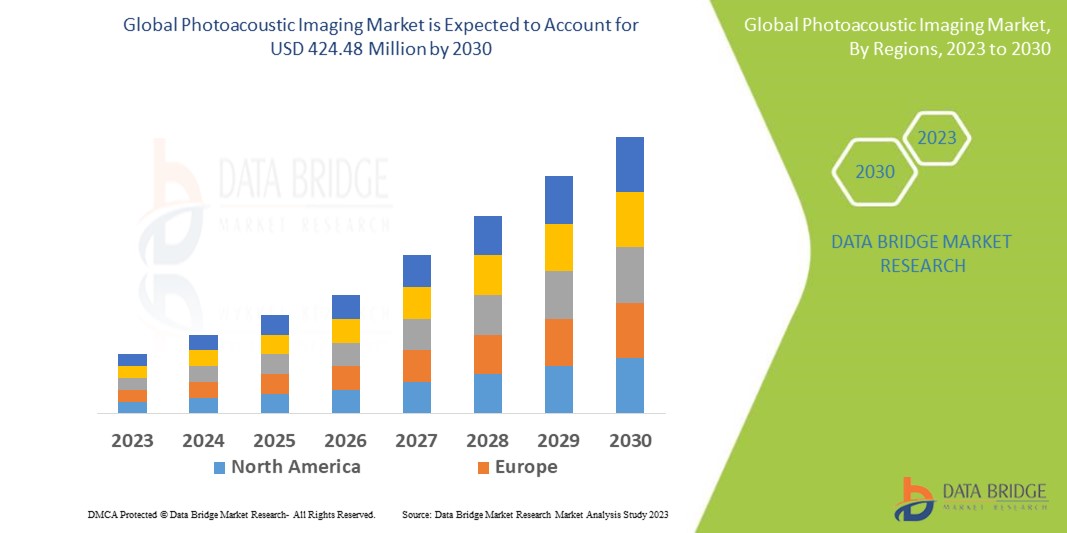Introduction
The global photoacoustic imaging market has been experiencing a consistent and promising growth trajectory, primarily attributed to the escalating adoption of this cutting-edge technology in both clinical and research domains. With its unique capability to seamlessly combine functional and structural information in medical imaging, photoacoustic imaging has garnered significant attention and recognition. This growth trend is poised to continue as the technology further matures and gains even broader acceptance within the healthcare and scientific communities. The ability of photoacoustic imaging to provide real-time insights into tissue characteristics and physiological processes has made it a valuable tool for various medical applications, ranging from cancer detection and monitoring to neuroimaging and cardiovascular assessment. As a result, the market for photoacoustic imaging solutions is expected to expand, serving as a testament to the technology’s potential to revolutionize the landscape of medical diagnostics and research.
Definition
In order to produce precise pictures of biological tissues and structures, photoacoustic imaging, sometimes referred to as optoacoustic imaging or photoacoustic tomography (PAT), combines the concepts of ultrasound with laser-induced optical absorption. Due to its distinctive characteristics and prospective uses, it is a non-invasive imaging technique that has attracted great interest in both clinical and research contexts.
Opportunities in photoacoustic imaging market
The photoacoustic imaging market offers several promising opportunities for growth and innovation:
- Advancements in Technology: Continued advancements in photoacoustic imaging technology, including improved imaging systems, better sensors, and enhanced image processing algorithms, present opportunities for more precise and detailed imaging.
- Expansion of Clinical Applications: There is room for the expansion of photoacoustic imaging into new clinical applications. Research and development efforts can focus on areas such as ophthalmology, obstetrics, and gynecology, opening up new markets and revenue streams.
- Integration with Other Imaging Modalities: Integrating photoacoustic imaging with existing imaging modalities like ultrasound, MRI, and CT can create hybrid imaging systems with complementary strengths, providing more comprehensive diagnostic information.
- Point-of-Care Devices: Developing portable and cost-effective photoacoustic imaging devices suitable for point-of-care use can enable healthcare providers to conduct rapid screenings and diagnostics in various settings, including rural and underserved areas.
- Oncology Applications: There is significant potential for photoacoustic imaging in oncology, especially in monitoring treatment responses and guiding minimally invasive procedures. Research into tumor characterization and vascular imaging can drive growth in this area.
- Neuroimaging: Exploring the use of photoacoustic imaging for studying brain function and neurological disorders can lead to breakthroughs in neuroscience and provide valuable clinical insights.
- Pharmaceutical Research: The technology can play a vital role in pharmaceutical research by enabling real-time monitoring of drug delivery and distribution within biological tissues.
- Therapeutic Monitoring: Photoacoustic imaging can be used to monitor the effectiveness of various therapies, including cancer treatments, by assessing changes in tissue characteristics over time.
- Global Market Expansion: Expanding into emerging markets where healthcare infrastructure is evolving offers substantial growth opportunities. Tailoring photoacoustic imaging solutions to the specific needs of these regions can be beneficial.
- AI and Image Analysis: Integrating artificial intelligence and machine learning algorithms for image analysis can enhance the speed and accuracy of diagnosis, making photoacoustic imaging even more valuable in clinical practice.
Expansion rate in photoacoustic imaging market
Data Bridge Market Research has conducted a comprehensive analysis of the global photoacoustic imaging market, revealing a compelling growth trajectory. In 2022, the market was valued at USD 107.71 million, and projections indicate a substantial expansion, with an anticipated market size of USD 424.48 million by the year 2030. This growth forecast corresponds to a remarkable compound annual growth rate (CAGR) of 18.7% over the forecast period from 2023 to 2030, signifying the market’s dynamic nature and its increasing significance in the field of healthcare and diagnostics.
Within the market’s component segment, “Hardware (component and substance medium)” emerges as the dominant category. This dominance can be attributed to the substantial investments pouring into the healthcare sector, where photoacoustic imaging technology is being harnessed to advance diagnostic capabilities and improve patient care. Hardware components play a pivotal role in the construction of photoacoustic imaging systems, and their significance in delivering accurate and high-quality imaging results further underscores their dominance in this market segment.
Safety and Ethical Considerations in Photoacoustic Imaging
Safety and ethical considerations are paramount in the development and application of photoacoustic imaging technology, especially in healthcare and medical research. Here’s an elaboration on these important aspects:
-
Patient Safety:
Non-Invasiveness: One of the key advantages of photoacoustic imaging is its non-invasive nature, which reduces the risk associated with traditional invasive procedures. This technology should continue to prioritize patient safety by minimizing discomfort and potential complications.
Exposure to Laser Light: Photoacoustic imaging uses laser light to generate acoustic signals. Ensuring that the laser intensity and duration are within safe limits is crucial to prevent tissue damage or adverse effects. Stringent safety standards and protocols must be followed during laser exposure.
Safe Wavelengths: Careful consideration of the laser wavelength used is important to avoid harm to sensitive tissues, such as the eye. Photoacoustic imaging systems should incorporate protective measures to prevent accidental laser exposure to operators and patients.
-
Data Privacy and Ethics:
Patient Privacy: Handling patient data and images should adhere to strict privacy regulations, such as HIPAA (Health Insurance Portability and Accountability Act) in the United States. Proper anonymization and encryption techniques should be in place to protect patient information.
Informed Consent: Ethical considerations require that patients are fully informed about the procedure, its purpose, and any potential risks or discomfort. Informed consent should be obtained before conducting any photoacoustic imaging studies involving human subjects.
Research Ethics: Ethical guidelines must be followed in research involving human participants. Institutional Review Boards (IRBs) should review and approve research protocols to ensure the ethical treatment of subjects.
-
Transparency and Accountability:
Accuracy and Validation: Developers and users of photoacoustic imaging systems must ensure the accuracy and reliability of the technology. Rigorous testing and validation procedures should be conducted to minimize the risk of misdiagnosis or misinterpretation of images.
Conflict of Interest: Ethical considerations include avoiding conflicts of interest, especially in cases where financial or commercial interests may influence research or clinical decisions related to photoacoustic imaging.
-
Regulatory Compliance:
Compliance with Regulatory Agencies: Photoacoustic imaging systems must adhere to regulatory requirements set by health authorities and government agencies to ensure their safety and effectiveness. This includes FDA (Food and Drug Administration) approval in the United States and similar regulatory bodies in other countries.
-
Environmental Impact:
Disposal of Components: Ethical and environmental considerations should extend to the disposal of components, such as lasers and electronic equipment, used in photoacoustic imaging systems. Proper disposal methods should be employed to minimize environmental impact.
Conclusion
In conclusion, photoacoustic imaging holds great promise in healthcare and research, but it must be developed and used with the utmost consideration for safety, patient privacy, and ethical principles. Adhering to established safety standards, regulatory requirements, and ethical guidelines is essential to ensure the responsible and beneficial deployment of this technology.
About Us
Data Bridge Market Research produces a wide range of market research reports covering diverse industries, including healthcare, technology, finance, and more. These reports offer in-depth analysis of market trends, opportunities, challenges, and key players.
The company provides customized research services tailored to the specific needs of clients. This includes market sizing, competitive analysis, industry benchmarking, and more.





